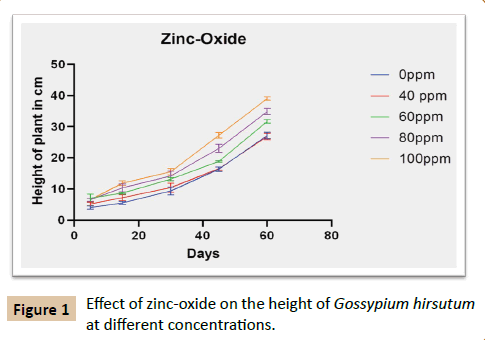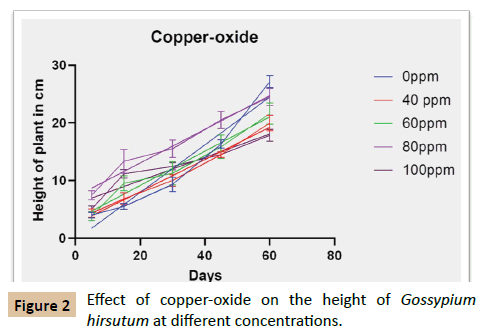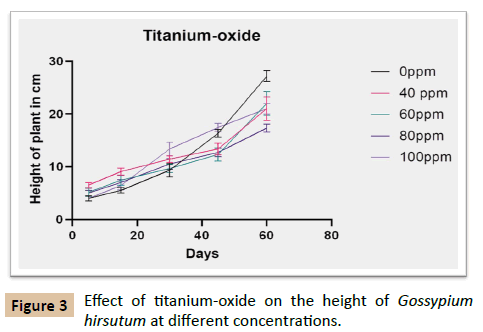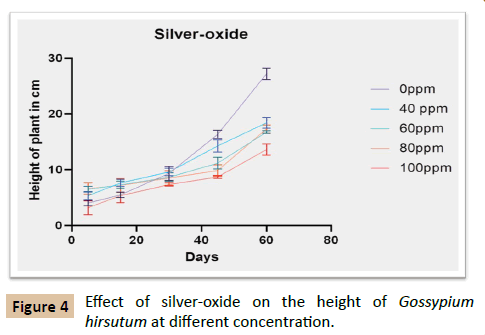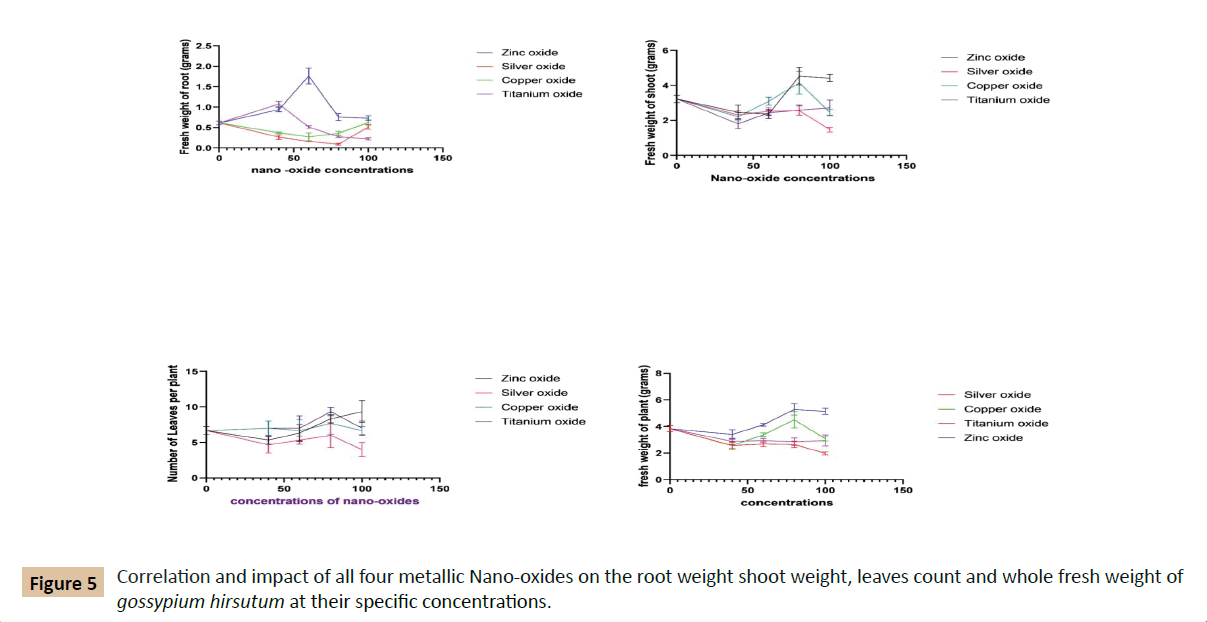Impact and Correlational Study of Engineered Metallic Nano-Oxide on the Growth and Development of Gossypium Hirsutum
Gaurav Sharma* and Anupriya Rana
School of Applied Sciences, Suresh Gyan Vihar University, Jaipur, Rajasthan, India
- Corresponding Author:
- Gaurav Sharma
School of Applied Sciences
Suresh Gyan Vihar University
Jaipur, Rajasthan, India
E-mail: gaurav.sharma@mygyanvihar.com
Received: March 04, 2021; Accepted: March 26, 2021; Published: April 05, 2021
Citation: Sharma G, Anupriya Rana (2021) Impact and Correlational Study of Engineered Metallic Nano-Oxide on the Growth and Development of Gossypium hirsutum. J Plant Sci Agri Res Vol.5 No.1:53
Abstract
Metallic nano-oxide has been influenced the environment in the past two decades. Their consequences are dreadfully uncertain. The increased graph of their interference suggested many extensive studies in various fields of the environment. The Gossypium hirsutum one of the prime harvest plants in India has been chosen for studying the impacts of metallic nano-oxide on their morphological characters as well as their fresh and dry weights. The need for the study was fulfilled by the four different metallic nano-oxides with their five specific concentrations. The metallic nano-oxides were titanium oxide, silver oxide, copper oxide, and zinc oxide. The five concentrations 00 ppm, 40 ppm, 60 ppm, 80 ppm, and 100 ppm were taken from each one of metallic nano-oxide. The zinc oxides treatment gave noteworthy positive development in Gossypium hirsutum from germination to the blossoming time. Conversely, the concentrations of silver oxides were found little toxic for the growth of species. The copper and titanium oxides indicated little diversity in their growth patterns. The germination studies calculated best with titanium oxide treatment. The 80 ppm concentration of copper oxide also reported better results at germination in comparison to control.
Keywords
Engineered metallic nano-oxides; Gossypium hirsutum; Morphological analysis; Fresh weight
Introduction
The Gossypium hirsutum sp. or commonly known as cotton is a very domestic and valuable crop plant in India. The crop plant of cotton placed itself in a zone of highly cultivated plants worldwide, but it is quite challenging with their growing pattern. The cotton plant also acquits shoot growth a little slower as compares to other species [1]. The world of science attains pretty much popularity in the field of nanotechnology because of their magnificent physiological properties and quantum effect [2]. There have been many studies conducted on plants and their micro-biome in corporation with nanoparticles. We had taken titanium oxide, silver oxide, copper oxide, and zinc oxide for studying their impression on growth impact on Gossipium sp. The several studies of above metallic nanoparticles have been done on different medicinal plants, crop plants, and on several microorganisms. The diversity of their effects on the environment makes them quite interesting and knowledgeable.
The metallic nano-oxide like zinc oxides have been reported as a quality growth promoter and increase the merestematic growth as well as chlorophyll and carbohydrate component of plants [3]. The silver oxides also have a significant effect in biomedical as well as agricultural field even there many studies that consider that silver nanoparticles have non-toxic effects on animal cell but having a toxicological effect on Bacteria cell make them a helpful and advanced bactericidal agent [4]. The other oxide which has been taken here, titanium oxide also enhances the plant growth and the photosynthetic rate in leaves of plants like spinach. The titanium oxides also responsible for increased growth rate in the electron transport chain at a very vast level. They just aren’t only given positive results in visible light but also proved themselves as a good enhancer in ultraviolet light too [5]. The copper oxide plays an essential role in the growth of plant and very helpful in increasing the biomass of plants like wheat [6].
The development ear of cotton can influence by several factors like climate, germplasm, and transient interaction [7]. The vegetative and reproductive growth of cotton purely depends on each other for their better development. If the initial growth rate measurements get affected badly then also the reproductive phase got the same downward effects. The surroundings, salinity, soil condition, and environmental factors are responsible for a better growth rate in the development of Gossypium hirsutum. The heat and temperature play a key role in the development of cotton. The crop handlers should be very careful about the temperatures during the growing time. The evaluation studies of cotton reveal that they have a very different tap root with basal and higher order. The developed tap root system helps the plant by getting deeper in the soil for the absorption of essential needs. Their higher order roots cannot tolerate the drought and depleted nutrition condition [8]. Cotton needs a warmer temperature and that plays a significant role in cotton development, every stage of cotton needs a specific temperature zone in an increasing order from germination to maturity. The nutrient uptake of cotton is also dependent on the temperature and propositional to the rate of heat and temperature [9]. The key nutrients for the better growth of cotton are phosphorous, nitrogen, potassium, and boron. Some secondary nutrients like magnesium, calcium, and sulfur also play significant role. The pH of the soil of cotton should be in between 6.0-6.5. The pH level of soil should be monitored before sowing the seeds [10]. The presence of phosphorous is a very important for the development of cotton because if the amount of phosphorous is less in soil, then it slows down the rate of absorption of Zinc, Nitrogen, and Potassium [11].
Materials and Methods
Environmental conditions
The study of the treatment of various specific concentrations of metallic nano-oxides with Gossypium hirsutum was conducted at the terrace-garden of Suresh Gyan Vihar University, Jaipur, India. The study has been started at a favorable time for cotton growth. The climatic condition was moderately hot temperature was near about 350°C-400°C as desired for better growth of cotton [12]. The soil of Jaipur is slightly alkaline in nature, the pH value is in between 8.3-9 [13] but as per requirement of the study, somehow little acidic soil is required for better growth of cotton species. A desirable amount of gypsum was added to the soil to reduce the pH level in between 5.8-7.6 [14]. The potassium level of soil also has been tested for better and unbiased results.
Nano-dose preparation
There were four metallic nano-oxide were used at different concentrations with crop plant of Gossypium hirsutum sp. The titanium oxides, silver oxides, copper oxides, and zinc oxides have been used at different concentration level like 00 ppm, 40 ppm, 60 ppm, 80 ppm, and 100 ppm. The metallic nano-oxides dose preparation has been done two days before the sowing of seeds. At the time of nano-dose preparation 100 ml of de-ionized water has been added to powdery metallic nano-oxides at specific concentrations. There were four concentrations of each metallic nano-oxide prepared in the form of sixteen colloidal solutions.
Plant material and plantation
The seeds of Gossypium hirsutum were taken from a well-known crop seed shop in Jaipur Rajasthan. The seeds were disease-free and quality checked. The seeds were sown in the rainy season of the Indian climate. The approximately 500 gm gypsum soil mixed with 100 gram of normal organic fertilizer like cattle manure to maintain the nutritional environment for seeds growth. The maximum 3 seeds were sown in each and every pot. At the time of sowing, every seed was placed 0.5 inch to 1 inch below the soil upper surface for better germination. Simultaneously, 10 ml of nano-oxide colloidal solution have been added to soil, exactly the same place where seed have sown. The study was done in the triplet with two controls, for having the best and unbiased results. The pots were placed at a partially shady place to avoid the excess of rainwater and intense sunlight.
Plant doses and growth monitoring
The first dose of each nano-oxides was given at the time of germination, control just watered by distilled water. The second replication was given after fifteen days and the third replication was on the 30th day. There were four doses of nano-oxides have been given to the plant till the 45th day. Plant morphological growth monitors every fourth day. The full morphological analysis was done in the form of plant height, shoot color, leaves count, bud timing and plant health. The fresh weight measurement of plants was done at the time of flowering. The fresh weight was measured in the form of root fresh weight, shoot fresh weight, and whole plant weight. The specific flowering stage has been noted till 60th day.
Result and Discussion
The positive or in warded growth impacts of nano-particles has been known in plants. The study has been done for the morphological parameter and plant fresh weight for up to 60 days. There were many ups and downs growth results of the metallic nano-oxide treatment have been seen on plants. The study reveals that the effect of the zinc-oxide was favorable for the positive morphological growth. The silver oxides showed an opposite direction. The interaction of silver oxide reduces the growth with increased dose concentration. The titanium and copper showed a little diversity in their growing pattern.
Effect of zinc-oxide on the morphological growth of Gossypium hirsutum
This has been observed in many previous studies that zinc-oxidel has been shown valuable effects on many crop plants as well as many other plant species. The zinc is also very essential for the carbohydrate metabolism of the plants [15]. It has been observed that zinc concentrations have been helpful for the induction of seed germination and initiate seedling [16]. The interaction of zinc oxide during study also demonstrated that the effect of zinc oxide is more productive than the other three remaining nanooxides. The treated plants with zinc were very healthy and fresh. The flowering time of zinc oxide treated plants were earliest as compare to the rest of them. The zinc oxide concentration was directly preoperational to the height, leaves count, and fresh weight of the plant. The increment of the concentration of nano-oxide from 40 ppm to 100 ppm lead to increase the height (Figure 1) as well as the fresh weight of plants. The concentration of 80 ppm and 100 ppm of zinc treatments were very significant for the shoot growth of the plant. The shoot was very healthy with best grams in fresh weight. The sustainable positive morphological results have been seen till the last phase of plant growth as compared to the control. The Concentration of 80 ppm and 100 ppm of zinc-oxide also showed the healthiest plant status as well as the earliest flowering stage. The maximum number of foliage also reported at zinc-oxide treatment in comparison to the other plants having different concentration of metallic nanooxide.
Effect of copper oxides on the morphological growth of Gossypium hirsutum
The induced copper oxides concentrations showed a concentration-specific role in many crop plants. They are also a key nutrient for better plant growth and functions as an activator for many enzymes in photosynthetic reaction [17]. Some plant studies also reported that copper causes a very specific and significant reduction or limits the seed germination [18]. In the present study case scenario, the copper oxides did not show a uniform growth pattern as zinc and silver oxide did. The copper oxides concentration of 40 ppm, 60 ppm, and 80 ppm initially enhanced the morphological parameter of the plant in comparison to control (Figure 2). At the middle phase of plant growth around between 25th to 40th day 40 ppm, 60 ppm, and 100 ppm were equivalent to control. There were neither positive nor negative results have been reported but concentration 80 ppm has given the best result. The lastly, copper oxide concentrations were not that effective for plant growth as they were in the initial growth phase. The plant growth was limited if we provide them continuous doses of copper nano-oxides. The 80-ppm concentration of copper showed a little fresher weight as compared to control. The flowering stage did not induce early as seen in case of zinc oxide.
Effect of titanium-oxide on the morphological growth of Gossypium hirsutum
The titanium oxides are well known for their unpredictable effects on crop plants. Each concentration of titanium oxides has variant effects on plant species [19]. Some studies were also proven that a small dose or concentration of titanium nano-oxide can improve the crop performance in different aspects [20]. In the case of titanium oxide treatment, all the concentrations were given the best results initially as compared to control. The germination results of titanium oxide treatment were seen productive. The highest morphological impact of 100 ppm concentration was seen till the 45th day (Figure 3). The titanium oxides effect falls at the time of flowering and control gave better results. The leaves count of titanium was very productive at 80 ppm concentration. The fresh weights were as alike as their height measures. Whereas 40 ppm concentration of titanium-oxide had shown much-developed root growth as compared to control. The early flowering did not even see in titanium oxide treated plants.
Effect of silver-oxide on the morphological growth of Gossypium hirsutum
The silver oxides showed a negative growth impact on the sp. of Gossypium hirsutum. As the concentration of silver nanooxide increases the development and morphological growth of plant get decreased. Plant morphological character like root and shoot growth and fresh weight of plant also get reduced with the treatment of silver [21]. Many studies revealed that phytotoxicity of silver affect the plants at their physiological level by reduction in chlorophyll content and nutrient uptake; reduce transpiration rate, and also alteration of hormonal activity. The silver oxide had been little toxic for prokaryotes and cell lines of mammals and it also showed very conflict results in various kinds of plant species [22]. The present study showed that silver treatment with species hasn’t shown a negative growth impact at the time of germination as well as in the initial growth of plants up to 80 ppm concentration. The 100 ppm concentration has been remained negative for all the majoring aspects of growth from germination to maturity. The plants growths were positive even better till the 30th day of growth at 40 ppm, 60 ppm, and 80 ppm concentration of silver nano-oxide. After the 30th day, growth of the plants didn’t work out well as compare to control and growth was retarded (Figure 4). The flowering period of the plant also has been slower as compared to control. The 80 ppm concentration affect root growth very negatively, it was hardly 1.5 cm in length. The fresh weight of 80 ppm plant root was very little as compared to other silver and different metallic concentrations. The leaves count or foliage was also getting vice versa effect due to having short stem length (Figure 5). The plants of silver oxides haven’t been that fresh and healthy as the other metallic oxides treated plants.
Correlational study of all four metallic nano-oxides
The detailed morphological study of four metallic nano-particles reveals that correlation between them had a very little relational degree. The zinc oxides exponential results were far better than any other metallic nano-oxide. The relational analysis between Titanium oxides, silver oxides and copper oxides showed almost indistinguishable effects up to 60 ppm concentration in the case of plants fresh weight. The overall result analysis stated that silver oxides were given the substandard developmental growth. The collation in between copper and titanium oxides, copper oxides proved themselves a better expectancy for growth.
Statistical Analysis
The statistical analysis was done by the software graph pad prism. The two-way ANNOVA test had been applied on morphological data. The results of two-way ANNOVA test at the 5% level (p=0.05) significant for all measurements evaluated. The results are presented as an average ± standard deviation. Test results were been significant with every morphological data of each nano-oxide treatment. The five different concentrations (00 ppm, 40 ppm, 60 ppm, 80 ppm, 100 ppm) of every nanooxide in respect to days were used to acknowledge the variation in respect to plant height, leave count, and fresh weight of plants. The significant F-test was obtained. The triplet data of each nanooxide concentration were provided for getting the best and mean result.
Conclusion
The nanoparticles impacts have been consistently capricious and shift species to species. This investigation of metallic nanooxide uncovers that among these four nano-oxide, zinc-oxide had been exceptionally noteworthy for the development of Gossypium hirsutum. The major morphological parameters of observation like height, leaves count, fitness, and fresh weight of root and shoot got decidedly influenced by the treatment with zinc-oxide. The copper and titanium oxides showed a variant pattern of morphological growth by their specific concentrations. Some of the concentrations like 60 ppm and 80 ppm of copper and titanium-oxide had been quite favorable for the growth of Gossypium hirsutum species. The leaves count was very good at 80 ppm concentration of titanium oxide. The copper oxide also showed positive results in the early stages of plant growth. The silver oxides showed a reduced fall pattern in the growth of plants especially at higher concentrations like 100 ppm. The germination and initial morphological growth didn’t affect much negatively with the concentrations of silver oxide 40 ppm and 60 ppm. The increasing ratio of concentrations and time period was not going positive in the case of silver-oxide treatment.
Acknowledgment
The authors acknowledge the DST Rajasthan India for providing fund under the major research project (DST Project: 7(3) DST/R and D/2016/3202) titled “Impact of engineered metal nanoparticles on micro-biome of agro ecosystem”.
References
- Robertson B, Bednarz C, Burmester C (2007) Growth and development: first 60 days. Cotton Physiol Today. 13:1-5.
- Samanta PK, Mandal AK (2017) Effect of nanoparticles on biodiversity of soil and water microorganism community. J tissue Sci Eng 8:196.
- Vitosh ML, Warncke DD, Lucas RE (1994) Secondary and micronutrients for vegetable and field crops, Michigan State University extension bulletin E-0486.
- Ojha S, Sett A, Bora U (2017) Green synthesis of silver nanoparticles by Ricinus communis var. carmencita leaf extract and its antibacterial study. Adv Nat Sci: Nanosci Nanotechnol 8:035009.
- Lei Z, Mingyu S, Chao L, Liang C, Hao H et al. (2007) Effects of nanoanatase TiO 2 on photosynthesis of spinach chloroplasts under different light illumination. Biological trace element res 119:68-76.
- Dimkpa CO, McLean JE, Latta DE, Manangón E, Britt DW et al. (2012) CuO and ZnO nanoparticles: phytotoxicity, metal speciation, and induction of oxidative stress in sand-grown wheat. J Nanoparticle Res 14:1-15.
- Bourland FM, Oosterhuis DM, Tugwell NP (1992) Concept for monitoring the growth and development of cotton plants using main-stem node counts. J Prod Agric 5:532-538.
- Ritchie GL, Bednarz CW, Jost PH, Brown SM (2007) Cotton growth and development. The University of Georgia. Cooperative extension.College of agricultural and environmental science & family and consumer sciences.
- Ritchie GL, Bednarz CW, Jost PH, Brown SM (2004) Cotton Growth and Development, University of Georgia Cooperative Extension
- Albers DW, Hefner SG, Klobe D (1993) Fertility Management of Cotton. Extension presentations.
- Duggan BL, Yeates SJ, Gaff N, GA Constable (2009) Phosphours fertilizer requirements and nutrient uptake of irrigated dry-season cotton grown on virgin soil in tropical Australia. Comm Soil Sci Plant Analysis 40:2616-2637.
- Reddy KR, Reddy VR, Hodges HF (1992). Temperature effects on early season cotton growth and development. Agro J 84:229-237.
- Ranjeet J, Chandel CPS (2017) Investigation of soil of Jaipur District of Rajasthan irrigated with water of Dravyavati River (Amanishah Nala) for its suitability for agricultural purposes. Int J Res App Sci Eng Technol 5:2779-2781.
- Growth and Development of a Cotton Plant. Advancing cotton education, Best mangament practices.
- Mousavi SR, Galavi M, Rezaei M (2013) Zinc (Zn) importance for crop production-a review. International J Agron Plant Prod 4:64-68.
- Laware SL, Raskar S (2014) Influence of zinc oxide nanoparticles on growth, flowering and seed productivity in onion. Int J Curr Microbiol Sci 3:874-881.
- Adhikari T, Kundu S, Biswas AK, Tarafdar JC, Rao AS (2012) Effect of copper oxide nano particle on seed germination of selected crops. J Agric Sci Technol 2:815.
- Rajput VD, Minkina T, Suskova S, Mandzhieva S, Tsitsuashvili V (2018) Effects of copper nanoparticles (CuO NPs) on crop plants: a mini review. BioNanoScience 8:36-42.
- Mattiello A, Lizzi D, Marchiol L (2018) Influence of titanium dioxide nanoparticles (nTiO2) on crop plants: a systematic overview. Nanomater Plants Algae Microorg 1:277-296.
- Lyu S, Wei X, Chen J, Wang C, Wang X, Pan D (2017) Titanium as a beneficial element for crop production. Front plant sci 8:597.
- Yan A, Chen Z (2019) Impacts of silver nanoparticles on plants: a focus on the phytotoxicity and underlying mechanism. Int j mol sci 20:1003.
- Vannini C, Domingo G, Onelli E, De Mattia F, Bruni I, Marsoni M, Bracale M (2014) Phytotoxic and genotoxic effects of silver nanoparticles exposure on germinating wheat seedlings. J Plant Physiol 171:1142-1148.
Open Access Journals
- Aquaculture & Veterinary Science
- Chemistry & Chemical Sciences
- Clinical Sciences
- Engineering
- General Science
- Genetics & Molecular Biology
- Health Care & Nursing
- Immunology & Microbiology
- Materials Science
- Mathematics & Physics
- Medical Sciences
- Neurology & Psychiatry
- Oncology & Cancer Science
- Pharmaceutical Sciences
